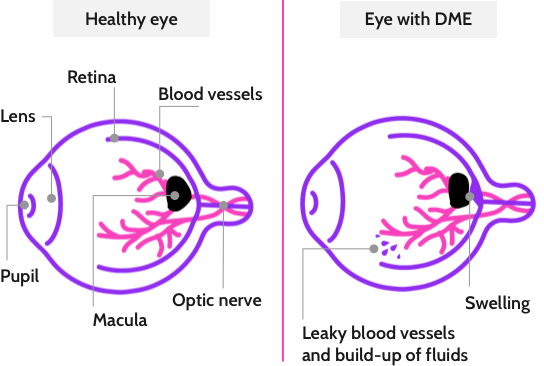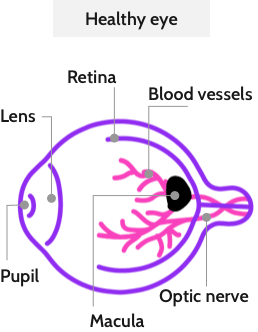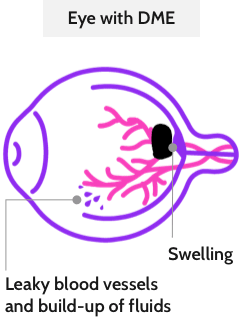Diabetic eye disease

Understanding diabetic eye disease1,2
Diabetic eye disease refers to conditions such as diabetic retinopathy (DR) and diabetic macular edema (DME).
These often result from uncontrolled high blood sugar levels and can lead to vision loss if left untreated.
If you’re concerned about yourself or a loved one, talk to your doctor and scroll to find out more.
Here are some of the key terms we use when talking about diabetic eye disease:
- Diabetic
A person is diabetic when they have diabetes, a disease that occurs when blood sugar levels are too high. - Retinopathy
Damage to the retina, the light-detecting part of the eye. - Macular
Affecting a part of the retina called the macula which is responsible for central vision.
- Edema
Build up of fluid that causes blurred and reduced vision. - Central vision
The part of your vision you use to focus clearly on something directly in front of you, like reading a book. - Peripheral vision
The part of your vision you use to gather rough information about your surroundings, like navigating through a crowd.
Symptoms of diabetic eye disease3
When it comes to diabetic eye disease, you may not experience symptoms until it progresses further.
While symptoms may vary from person to person, they’re usually a combination of those shown below:
Diabetic eye disease risk factors4
Here are the key risk factors for diabetic eye disease to bear in mind:
How does diabetic eye disease affect the eye?
Two types of diabetic eye disease1,2
There are two types of diabetic eye disease, including conditions like DR and DME.
Diabetic
retinopathy
(DR)
The early stage is called DR.
Not all people with DR experience changes in vision until this disease progresses.
That’s why it’s important for people with diabetes to watch out for any changes in vision, no matter how small.
Diabetic
macular edema
(DME)
The later stage is called DME.
Over time, DR can turn into DME as the retina becomes more damaged.
50% of people with DR develop DME.2
Diabetic retinopathy2
Diabetic retinopthay (DR) is an eye condition that can cause vision loss in people with diabetes.
How does DR develop?
- Sugar blocks tiny blood vessels in the retina.
- Due to the blockage, these blood vessels start to leak fluid or bleed.
- This leads to swelling and blocks the blood supply to some parts of the retina.
If you have DR, you might not experience any vision problems until complications occur.
Diabetic macular edema2
Over time, DR can lead to diabetic macular edema (DME).
How does DME develop?
- In DME, damaged blood vessels start to leak into the retina.
- This can lead to a build-up of fluid in the eye which can cause swelling, otherwise known as edema.
- When this swelling happens in the macula, it leads to blurred or weakened vision.



References
1.Kellogg Eye Center. DME [Internet; cited March 2021]. Available from: https://www.umkelloggeye.org/conditions-treatments/diabetic-retinopathy
2.National Eye Institute. Facts About Diabetic Eye Disease. [Internet; cited March 2021]. Available from: https://nei.nih.gov/health/diabetic/retinopathy
3.American Academy of Ophthalmology. Diabetic Retinopathy Symptoms. [Internet; cited March 2021]. Available from: https://www.aao.org/eye-health/diseases/what-is-diabetic-retinopathy
4.Lee R, Wong TY, Sabanayagam C. Epidemiology of diabetic retinopathy, diabetic macular edema and related vision loss. Eye Vis. 2015; 2:17.














